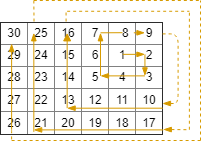On a 2 dimensional grid with R rows and C columns, we start at (r0, c0) facing east.
Here, the north-west corner of the grid is at the first row and column, and the south-east corner of the grid is at the last row and column.
Now, we walk in a clockwise spiral shape to visit every position in this grid.
Whenever we would move outside the boundary of the grid, we continue our walk outside the grid (but may return to the grid boundary later.)
Eventually, we reach all R * C spaces of the grid.
Return a list of coordinates representing the positions of the grid in the order they were visited.
Example 1:
Input: R = 1, C = 4, r0 = 0, c0 = 0
Output: [[0,0],[0,1],[0,2],[0,3]]

Example 2:
Input: R = 5, C = 6, r0 = 1, c0 = 4
Output: [[1,4],[1,5],[2,5],[2,4],[2,3],[1,3],[0,3],[0,4],[0,5],[3,5],[3,4],[3,3],[3,2],[2,2],[1,2],[0,2],[4,5],[4,4],[4,3],[4,2],[4,1],[3,1],[2,1],[1,1],[0,1],[4,0],[3,0],[2,0],[1,0],[0,0]]

Runtime: 72 ms, faster than 32.30% of C++ online submissions for Spiral Matrix III.
大概思路就是不要考虑限制和边界,把路径都走一遍,然后符合题意的放进结果。
#include <stack>
#include <algorithm>
#include <queue>
#include <unordered_map>
#include <vector>
#include <unordered_set>
#include "header.h"
using namespace std;
class Solution {
public:
int R;
int C;
bool canadd(int x, int y){
return x < R && x >= 0 && y < C && y >= 0;
}
vector<vector<int>> spiralMatrixIII(int _R, int _C, int r0, int c0) {
R = _R;
C = _C;
int cur = 1, MaxSize = R * C, len = 0 ,cnt = 0;
vector<vector<int>> mtx = {{r0,c0}};
while(cur < MaxSize){
cnt = 0; len++;
while(cnt < len && c0 < 2*C){
cnt++; c0++;
if(canadd(r0, c0)) {
mtx.push_back({r0, c0});
cur++;
}
}
cnt = 0;
while(cnt < len && r0 < 2*R){
cnt++; r0++;
if(canadd(r0, c0)){
mtx.push_back({r0, c0});
cur++;
}
}
cnt = 0;
len++;
while(cnt < len && c0 >= -C+1){
cnt++; c0--;
if(canadd(r0, c0)){
mtx.push_back({r0, c0});
cur++;
}
}
cnt = 0;
while(cnt < len && r0 >= -R+1){
cnt++; r0--;
if(canadd(r0,c0)){
mtx.push_back({r0, c0});
cur++;
}
}
}
return mtx;
}
};